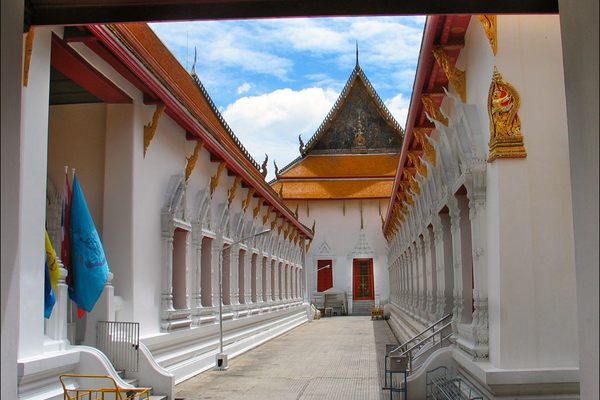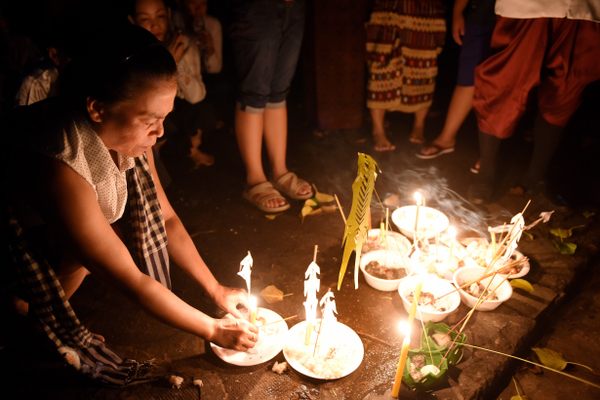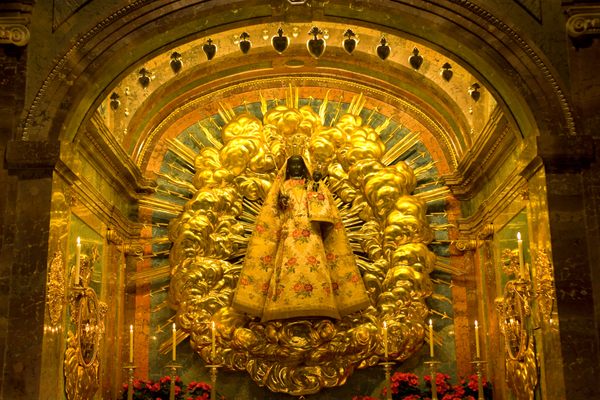Sarira: Buddhist Human Pearls
Buddhist relics from His Holiness Supreme Patriarch of Thailand in Wat Khung Taphao (photograph by Tevaprapas Makklay)
Human beings as a whole are obsessed with leaving behind a legacy. And our religious practices around death certainly reflect that desire.
European saints are always leaving behind finger bones, vials of blood, breast milk, bloody faces on towels. As recently as 1983, even Jesus’ holy foreskin was paraded through the Italian village of Calcata on the feast day of the Circumcision (January 1, in case you were wondering, although the foreskin has since gone missing).
So what are pious Asian holy figures leaving behind?
On a trip to Hong Kong, I first encountered sarira in the innermost sanctum of a museum, housed within a giant bronze Buddha. Surrounded by bulletproof glass and nestled within golden vessels and velvet platforms, the shiny nubs were hard to make out. Squinting, I could see what looked like pinkish sea glass before I was yelled at for even thinking of taking out my camera and for not just scurrying past like everyone else. While sharing a vegetarian lunch at the adjacent monastery, I inquired a bit into sarira. None of my tablemates seemed to know too much, but my interest into these “human pearls” was piqued.
An exhibition of sacred Buddhist relics (courtesy Maitreya Loving Kindness Tour)
Although the term sarira comes from the Sanskrit word for “body” (शरीर), and can be used for relics like teeth or parts of Buddha’s skull, it typically refers to the crystalline traces that remain after a respected Buddhist’s corpse is burnt. After cremation, monks will sift for sarira through the dusty ashes of venerated saints and teachers. In Korea, unburnt bits of bone are set aside to be ground up, mixed with meal, and then left for animals. The sarira themselves stand out as little chunks of crystal or colored stone.
Interestingly, this means that sarira are foreign to the body, neither bone nor flesh. Instead, these strange beads are seen as the final distillation of a Buddhist life well-lived, a physical manifestation of piety and devotion.
Collected sarira (courtesy Maitreya Loving Kindness Tour)
In some cases, sarira are said to grow from the bodies of living people, usually at the culmination of a religious experience. For example, a Tibetan yogi named Chosyang Dorje Rinpoche allegedly spent 45 years meditating on love and joy. At the end of these long years, 2,000 pearl-shaped sarira were said to have dangled from his hair.
Shakyamuni Buddha’s Blood Relics; saffron threads are a common offering stored with sarira. (courtesy Maitreya Loving Kindness Tour)
Depending on which part of the body the sarira grew from, various colors and sizes are possible, each with a distinct traditional name. For example, yellowish churira are typically the size of mustard seeds and originate from the liver, while white pea-sized sharira are associated with the head, and nyarira manifest themselves from lung tissue.
Reliquary holding remains of Gautama Buddha (photograph by Teresa Merrigan)
As with any relics, a host of legendary properties have been attributed to sarira. Sarira have been known to mysteriously multiply, grow, or decrease in size while inside their containers, depending on the purity of the keeper’s thoughts. When placed on the crown of the head, the sarira are said to heal and purify the body.
Healing with sarira (courtesy Maitreya Loving Kindness Tour)
Of course, skeptics have propounded all kinds of explanations for sarira. They might be just natural minerals that collect in human bodies (like gallstones) that we typically don’t bother looking for at the crematorium. Or they might be crystalline structures that form under the heating conditions of cremation.
You can go with a scientific or spiritual rationalization, but you can also judge for yourself after checking out the traveling Heart Shrine Relic Tour, a dual exhibition of hundreds of sarira, a collection to which the Dalai Lama donated eight relics. The two exhibitions open this Friday, February 14, in Morelia, Mexico, and Hobart, Tasmania, respectively, and continue later this month to Querétaro, Mexico, and Eudlo, Queensland. You can find the full schedule online.
EXPLORE MORE RELICS OF BUDDHISM:
TIAN TAN BUDDHA, Hong Kong: The inside of the giant Buddha holds cremated remains
WAT MAHATHAT, Bangkok, Thailand: One of Bangkok’s oldest temples was originally built as a reliquary
TEMPLE OF THE TOOTH, Kandy, Sri Lanka: This elaborate temple was built around one of the Buddha’s teeth

















Follow us on Twitter to get the latest on the world's hidden wonders.
Like us on Facebook to get the latest on the world's hidden wonders.
Follow us on Twitter Like us on Facebook